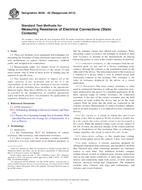We need your consent to use the individual data so that you can see information about your interests, among other things. Click "OK" to give your consent.
ASTM B539-02(2013)
Standard Test Methods for Measuring Resistance of Electrical Connections (Static Contacts)
STANDARD published on 1.8.2013
The information about the standard:
Designation standards: ASTM B539-02(2013)
Note: WITHDRAWN
Publication date standards: 1.8.2013
SKU: NS-7081
The number of pages: 7
Approximate weight : 21 g (0.05 lbs)
Country: American technical standard
Category: Technical standards ASTM
The category - similar standards:
Annotation of standard text ASTM B539-02(2013) :
Keywords:
connection resistance, connectors, contact resistance, contacts, electrical resistance, junction resistance, low level contact resistance, separable connections, ICS Number Code 29.120.20 (Connecting devices)
Additional information
| Significance and Use | ||||
|
5.1 As stated in Terminology B542, contact resistance is comprised of a constriction resistance and a film resistance. When present, the latter of these is usually much greater in value and dominates the contact resistance. For a given contact spot, when the film resistance is zero or negligible the contact resistance for that spot is nearly the same as the constriction resistance and therefore, as a practical matter, has a minimum value which represents a clean metal-to-metal contact spot. As real contact surfaces exhibit varying degrees of roughness, real contacts are necessarily composed of many contact spots which are electrically parallel. In practical cases the clean metal-to-metal contact spots will carry most of the current and the total contact resistance is primarily dependent on the size and number of metallic contact spots present (see Note 1). In addition, acceptably low values of contact resistance are often obtained with true areas of contact being significantly less than the apparent contact area. This is the result of having a large number of small contact spots spread out over a relatively large apparent contact area. 5.2 The practical evaluation and
comparison of electrical connections depend in large part on their
contact resistance characteristics. On the one hand, the absolute
value of contact resistance is greatly dependent on the amount of
metallic contact established and indicates initially how efficient
the system is in producing areas of metallic contact. On the other
hand, a comparison of the initial resistance to the resistance
after aging indicates how stable the system is in maintaining the
initial contact area. Both of these characteristics should be
considered when evaluating contact systems. The criteria employed
in evaluating contact resistance and stability are not a part of
these test methods as they depend on specific applications and
therefore, will not be quantitatively stated. However, an estimate
of contact resistance1.1 These test methods cover
equipment and techniques for measuring the resistance of static
electrical connections such as wire terminations or splices,
friction connectors, soldered joints, and wrapped-wire
connections.
1.2 Measurements under two distinct levels of electrical loading are described. These levels are: (1.3 This standard does not purport to address all of the safety concerns, if any, associated with its use. It is the responsibility of the user of this standard to become familiar with all hazards including those identified in the appropriate Material Safety Data Sheet (MSDS) for this product/material as provided by the manufacturer, to establish appropriate safety and health practices, and determine the applicability of regulatory limitations prior to use. |
||||
| 2. Referenced Documents | ||||
|
We recommend:
Updating of laws
Do you want to be sure about the validity of used regulations?
We offer you a solution so that you could use valid and updated legislative regulations.
Would you like to get more information? Look at this page.




 Cookies
Cookies
